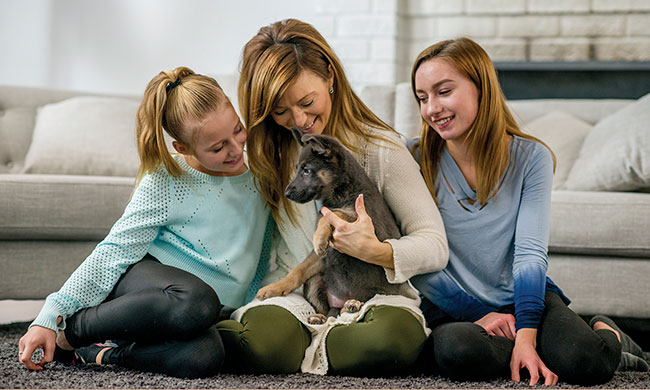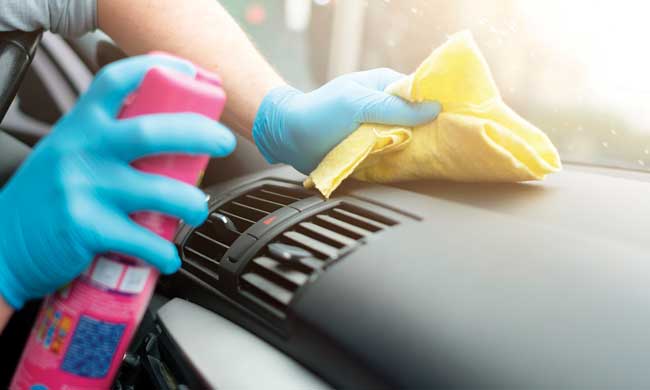Live Better
How to welcome a new puppy to the family

Introducing a new puppy to your household can bring many rewards. However, getting the hang of things can take some time, especially for first-time pet owners.
In fact, it takes the average pet owner almost four months to get into the flow with a new four-legged family member, according to a survey by Royal Canin. Eight in 10 respondents said the first year of pet ownership is the most important, but that doesn’t mean it’s easy. The survey found 64% believe the first year is also the most difficult and deciding how to train a new pet was cited as the most important decision pet parents have to make.
“Bringing a puppy home is a hugely rewarding experience for pet owners, but it’s also a time of huge challenges and steep learning curves,” said Dr. Jill Cline, pet nutritionist and site director of Royal Canin’s Pet Health and Nutrition Center. “In addition to helping your puppy adjust to its new home, you can support your puppy’s health now and always with a nutritionally complete diet tailored to its specific needs.”
Make welcoming a new puppy a rewarding experience for the whole family with these tips.
Arriving Home
Your puppy may be feeling stressed by new sights, sounds, smells and the separation from its mother. Manage the noise and activity to avoid adding to this stress.
As soon as you get home, take your puppy to your yard or outside area so it can go to the bathroom. Use positive verbal reinforcement when the job is done.
Once indoors, block off a safe area and let your puppy sniff and explore on its own time. Getting acquainted with a new place takes time and lots of exploring. Some puppies can be overwhelmed by too much human contact, so allow your puppy to come to you.
Getting Settled
Puppies like to know what to expect. Plan your routine for feeding, potty trips, exercise and grooming so you can get started on day one. If you know what routine your puppy had before adoption, it’s best to continue for consistency until your puppy is settled.
Any sudden dietary changes can cause stress or digestive problems, so for the first week or two, give your puppy the same food as its previous owner, following the feeding recommendations on the package. Nutrition tailored to specific developmental needs can help fragile, young puppies grow into strong, healthy dogs. It’s important to select a high-quality food based on age and expected adult size.
Your puppy’s eating spot should be away from where you and any other pets eat. Allow your puppy to eat in peace to prevent it from feeling nervous or protective.
Puppies tire easily and need as much as 18-20 hours of sleep per day for healthy development. A crate near where you sleep lets your puppy see and smell you but keeps it from wandering off. Put something that carries your scent in your puppy’s bed along with a blanket to snuggle into.
Remember to schedule regular veterinarian visits and gradually introduce your puppy to new experiences like sounds, car travel, walks and other animals. It’s also important to begin behavior training right away to develop good habits from the start.
If you’re interested in getting a new puppy, before making a decision on which breed best suits your family and lifestyle, you can see all 196 registered breeds during the 2021 AKC National Championship. Find more advice for welcoming a new puppy into your home at RoyalCanin.com/puppies.
Photo courtesy of Getty Images
SOURCE:
Royal Canin
Live Better
8 must-visit destinations for you next getaway

(Family Features) For many travelers, the thrill of discovering unique and memorable experiences ignites a desire for new adventures – whether gathering with family, escaping routines or celebrating milestones.
From the bustling cityscapes to serene beachfront retreats, Hyatt hotels offer guests and members memorable travel experiences in sought-after destinations from Chicago to Cancun and beyond.
If you’re craving a getaway, get inspired by these eight destinations and plan your next vacation at Hyatt.com.

Embark on Urban Adventures in Chicago
Presiding in the heart of downtown Chicago, Chicago Athletic Association, part of The Unbound Collection by Hyatt brand, is steps from iconic landmarks such as Millennium Park, the Art Institute of Chicago and Maggie Daley Park. The landmark hotel offers seven celebrated dining and drinking establishments and boasts 240 guestrooms and suites that blend modern amenities with nods to its historic, athletic roots with stunning views of Lake Michigan.

Enjoy Ski-In, Ski-Out Luxury
Whether looking for a luxury ski getaway or a mountain adventure, Grand Hyatt Vail and Park Hyatt Beaver Creek Resort and Spa offer something for everyone. Both offer direct access to the mountain and ski valet services, so skiers can forget about carrying gear or dealing with cold boots. The hotel hot tubs can help guests leave behind mountain soreness in a serene environment.

Relax, Play and Indulge in Tranquility
Nestled in Greater Palm Springs, Grand Hyatt Indian Wells Resort and Villasoffers world-class accommodations following a $64 million hotel-wide renovation, including redesigned guestrooms and luxury villas, refreshed meeting and event spaces, two new dining concepts and a reimagined pool complex featuring a lazy river, splash pad and dueling water slides. Plus, the on-site spas provide advanced treatments like IV hydration, custom massages, body scrubs, microneedling and more.

Make Yourself at Home in the Nation’s Capital
Located in the buzzing Wharf neighborhood near the National Mall with dazzling views of the Potomac River, Hyatt House Washington, D.C./The Wharf is an ideal spot to recharge before exploring historic Washington, D.C. The hotel, which is the perfect home base for exploring nearby attractions like The Smithsonian and the Lincoln Memorial, is home to rooftop pool views and on-site dining as well as spacious rooms with separate seating areas and sofa beds – making it the perfect home away from home.

Unwind in Orange County
Indulge in SoCal vibes at Hyatt Regency Irvine. Located in Irvine, California, you’ll be near some of the area’s top activities, including Disneyland, Newport Beach and shopping at South Coast Plaza. Take advantage of the hotel’s swimming sanctuary, which was redesigned as part of a $55 million hotel-wide renovation and features luxurious cabana options like fire-pit seating, hospitality cabanas or shaded retreats.

Escape to the Shores of Paracas Bay
Relax amid the natural beauty of Peru’s southern coast at The Legend Paracas Resort, part of the Destination by Hyatt brand, a family-friendly, oceanfront basecamp for adventure. Adjacent to Paracas National Park, the immersive resort provides opportunities to explore the Ballestas Islands on a thrilling boat tour, soar over the enchanting Nazca Lines on a private charter flight or conquer the Huacachina desert in dune buggies.

Retreat to Well-Being
Tucked among 23 secluded acres at the base of Camelback Mountain, Andaz Scottsdale Resort & Bungalows is a luxury resort within a desert oasis. Guests can embark on a journey of adventure and relaxation with rejuvenating treatments available at Palo Verde Spa & Apothecary, three luxurious pools, 185 spacious bungalows and suites, renowned dining, craft cocktails and more.

Experience All-Inclusive by the Sea
Nestled between the natural Bahia Petempich beach and the Caribbean Sea, Hyatt Ziva Riviera Cancun ignites your senses with dramatic ambiance, vibrant cuisine and modern amenities in a family-friendly atmosphere where food, drink and activities are all included. Surrounded by a lush jungle and sparkling waters, it offers a nearly endless list of activities for the whole family, including the serene Zen Spa and a winding water park.
SOURCE:
Hyatt
Live Better
Cost-efficient car detailing at home

(Family Features) Having your car professionally detailed is likely to set you back a chunk of change, but with the right supplies and a little spare time, you can get similar results at home.
Whether you’re washing away winter grime or just giving your ride some overdue attention, follow these steps to get your vehicle in tip-top shape.
Assess your vehicle’s condition. If there’s a specific problem you need to address, such as stains or excessive insect buildup on your front bumper, those are areas you’ll want to focus your time, energy and budget.
Purchase the necessary supplies. A car cleaning kit could simplify the shopping process, but you may need to supplement with additional items, such as a spot treater, to achieve the best results. The essentials include a sturdy bucket, washing mitt, soft bristle brush, soft rags, a dust rag, automotive soap, glass cleaner, a vinyl or interior-safe cleanser, vacuum and wax, if you wish.
Empty the vehicle. Removing all your personal possessions provides a blank slate for cleaning and prevents you from having to work around or worry about damaging your belongings. Also remove any elements of the vehicle you may want to clean separately, such as floor mats, console inserts and other removable pieces.
Tackle the interior. Start by removing debris from crevices and wiping away dust and other gunk. Then, with the initial layer of mess removed, go back and wipe down all surfaces using a cleanser. You can also clean the interior windows at this stage, and be sure to wipe down the console, especially if you have a touchscreen that is covered with fingerprints.
Vacuum thoroughly. Using a small vacuum or hose with strong suction, pay special attention to high-traffic areas and spaces where trash and debris tend to settle, such as between the seat and console. The floorboards will likely need the most attention, but don’t overlook the seats, and especially the area where the seat and back meet as this crevice can trap a great deal of dirt.
Clean the floor mats. Chances are good your floor mats rival the exterior for the dirt and grime they accumulate. Depending on how heavily soiled they are, and especially if they’re carpet-style mats, you may want to shampoo them after a deep vacuuming to remove stubborn stains.
Return belongings to the interior. Before you add everything back into your vehicle, take time to wipe down items and sort out any unnecessary clutter. It’s a good time to reorganize your storage areas to be sure the items you use frequently are in easy reach. You can also replenish supplies such as facial tissue and hand sanitizer.
Wash the exterior. Follow the instructions on the product’s label to wash your automobile’s exterior. Pay attention to special requirements such as allowing time for a bug remover to soak. In general, start with a rinse, followed by scrubbing with a mitt then an all-over rinse. Use a chamois towel or other drying cloth to avoid water spots.
Add finishing touches. If you’re using wax or planning on specialty treatments like tire cleaning, those will be among your final steps. Last but not least, clean the exterior windows with glass cleaner to remove streaks and leave them sparkling.
Find more practical vehicle maintenance tips at eLivingtoday.com.
Photo courtesy of Shutterstock
SOURCE:
eLivingtoday.com
Live Better
5 tips for new pet owners

(Family Features) Welcoming a new pet is exciting, but preparation is needed to provide a loving home and enjoy the unconditional love.
Prepare your furry friend for a new home with these essential tips for first-time pet owners.
Choose the Right Pet for Your Lifestyle
Consider your living situation, work schedule and personal preferences. Research different breeds to find the one that matches your activity level, living space and family dynamics. Also consider any allergies or sensitivities you or your family may have as some pets may trigger allergies or asthma symptoms.
Set Up Your Home
Before bringing your new pet home, create a safe and comfortable environment. Start by pet-proofing your home, removing any hazardous substances and securing loose wires or cords. Make sure to store cleaning supplies, medications and toxic plants out of reach. Provide a designated space that includes a cozy bed or crate, food and water bowls and toys.
Create a Routine
Establish a consistent schedule for feeding, exercise and bathroom breaks. Determine the appropriate amount and frequency of meals for your pet’s age, size and breed. Spend quality time with your pet daily, providing attention, affection and mental stimulation.
Budget for Your Pet’s Needs
Owning a pet comes with financial responsibilities. Consider the costs of food, grooming, veterinary care, vaccinations and preventive medications. Additionally, factor in the cost of toys, bedding, litter and other supplies.
Find a Reliable Veterinarian
Regular check-ups and open communication with a local veterinarian can help detect any potential health issues early and ensure your pet receives the best possible care. Ask friends, family or neighbors with pets for provider recommendations and read reviews. Visit potential veterinarians’ offices to meet the staffs, tour the facilities and ask any questions you may have.
Find more tips for welcoming a furry friend into your home at eLivingtoday.com .
Photo courtesy of Unsplash
Watch video to find out how!
SOURCE:
eLivingToday.com
-

 NEWS2 years ago
NEWS2 years ago2 hurt, 1 jailed after shooting incident north of Nocona
-

 NEWS1 year ago
NEWS1 year agoSuspect indicted, jailed in Tia Hutson murder
-

 NEWS2 years ago
NEWS2 years agoSO investigating possible murder/suicide
-

 NEWS2 years ago
NEWS2 years agoWreck takes the life of BHS teen, 16
-

 NEWS2 years ago
NEWS2 years agoMurder unsolved – 1 year later Tia Hutson’s family angry, frustrated with no arrest
-

 NEWS2 years ago
NEWS2 years agoSheriff’s office called out to infant’s death
-

 NEWS2 years ago
NEWS2 years agoBowie Police face three-hour standoff after possible domestic fight
-

 NEWS2 years ago
NEWS2 years agoDriver stopped by a man running into the street, robbed at knifepoint







